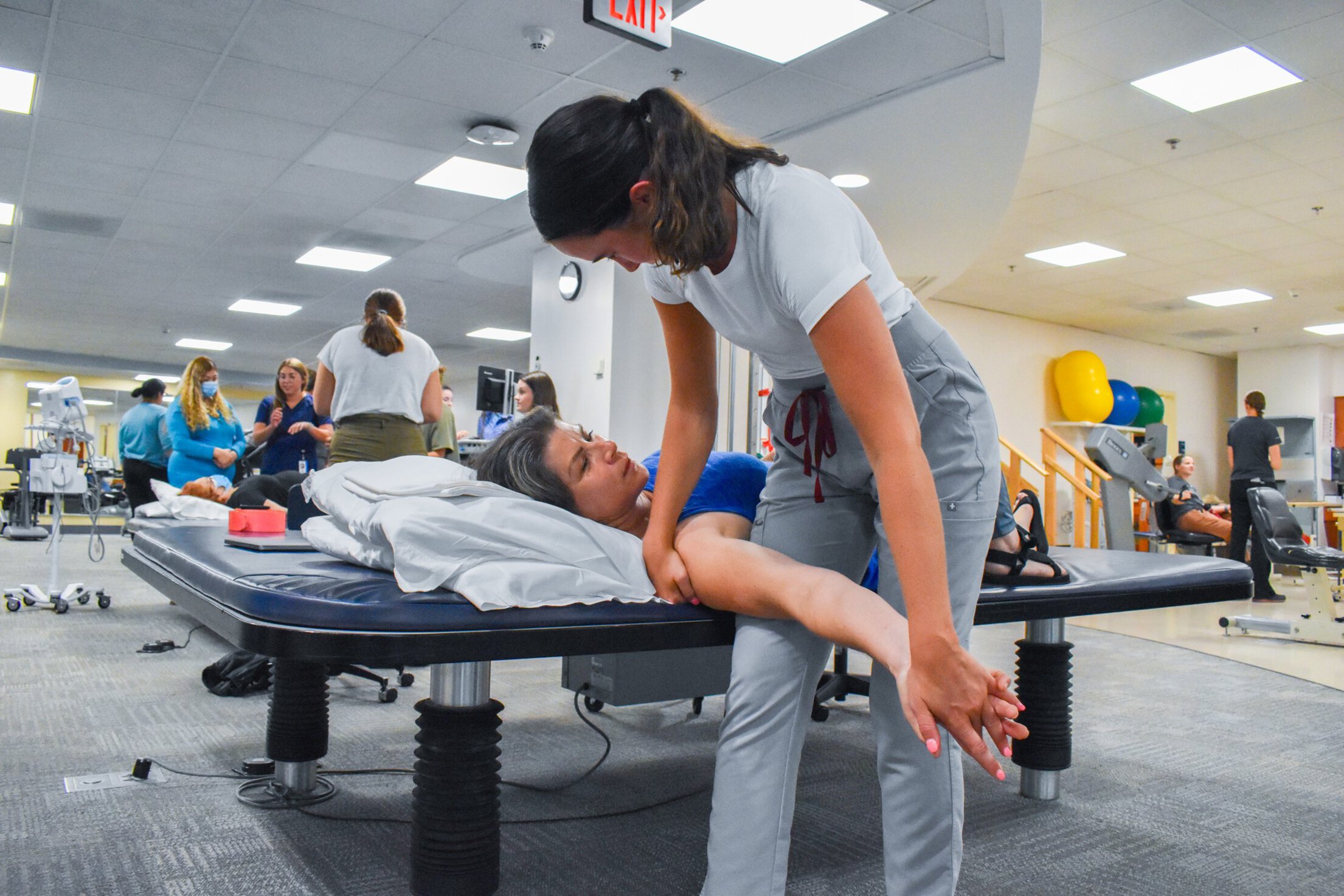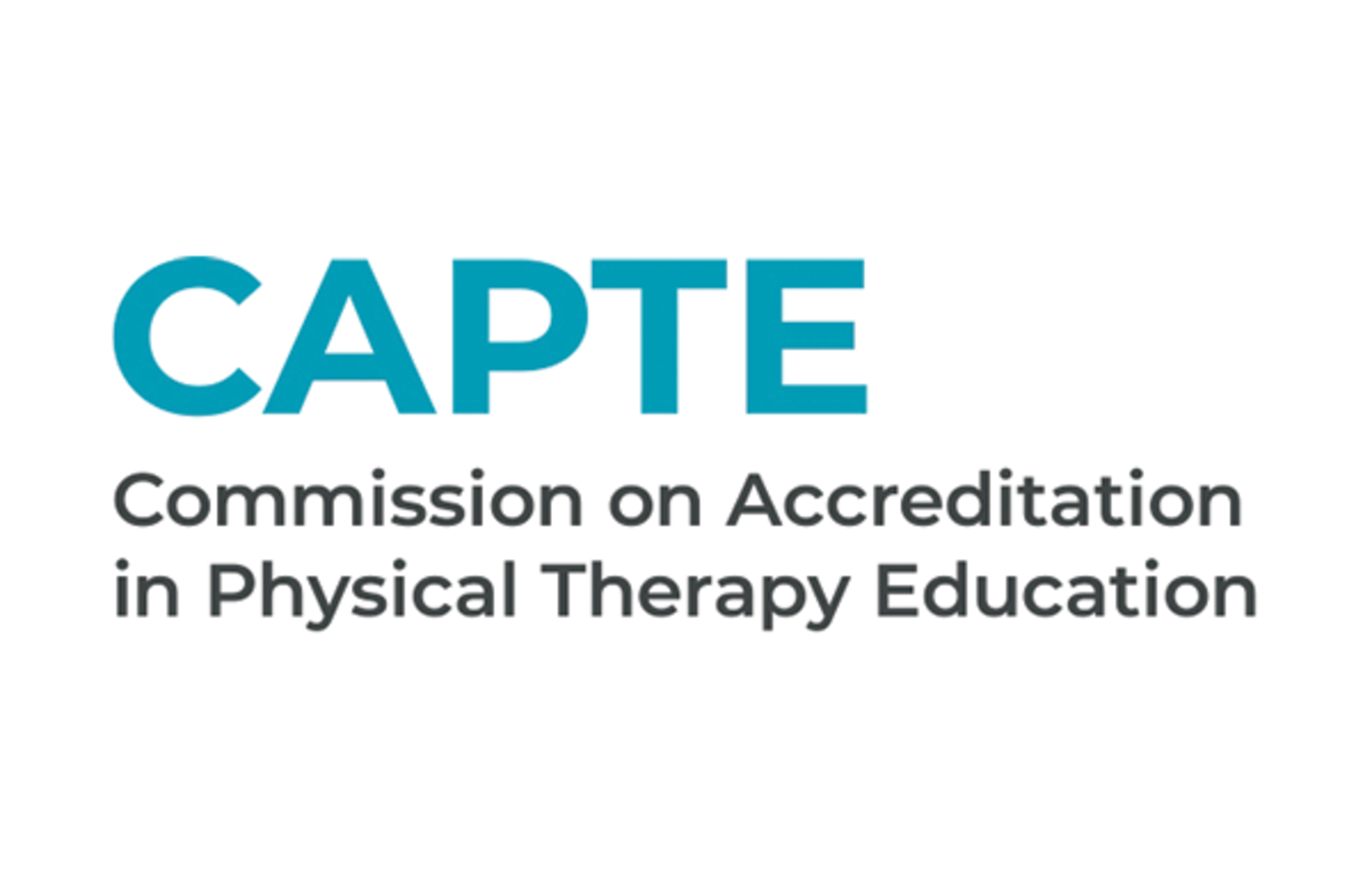MUSC MS in Physician Assistant Studies Virtual Information Session
- calendar_today Thursday, Jan. 8

The Doctor of Physical Therapy – Hybrid (DPT) program blends the excellence of our #22 nationally ranked, eight-semester curriculum with the accessibility of hybrid learning. Enjoy engaging online coursework, both live and self-paced, paired with 12 immersive lab sessions in Charleston, SC, over the first six semesters. Learn from expert faculty, collaborate in interprofessional teams and access state-of-the-art facilities and a world-class teaching hospital. Customize your journey through research, advanced clinical study, or medical mission trips. Since 1973, MUSC has prepared leaders in physical therapy through excellence in education, research and service.
APTA PTCAS
Jun 16, 2025 – Jan 15, 2026
MUSC
Jul 1, 2025 – Jan 15, 2026
Gain personal guidance from a dedicated faculty coach, connect with a supportive cohort and thrive through engaging online learning and hands-on labs in Charleston, SC.
The Doctor of Physical Therapy – Hybrid (DPT) program offers the prestige of our nationally ranked, eight-semester curriculum with the geographic flexibility of hybrid learning. Experience the best of both worlds, dynamic online coursework in live and self-paced formats combined with 12 immersive lab sessions in Charleston, SC, over your first six semesters. These hands-on sessions take place in expansive, state-of-the-art facilities and are led by expert faculty and clinicians from across the nation.
From day one, you’ll follow an evidence-based curriculum that blends foundational science with advanced clinical skills, focusing on human movement, health promotion and disease prevention. After your second semester, customize your education by joining faculty-led research projects, exploring specialized clinical areas, or serving on medical mission trips.
Your clinical training includes three diverse practicums across the U.S. and Puerto Rico, exposing you to settings such as acute care, rehabilitation hospitals, outpatient clinics, schools and specialized centers. Along the way, you’ll engage in impactful service learning, including the nationally recognized MUSC CARES Therapy Clinic, adaptive sports programs and community outreach initiatives.
In just 2.8 years, you’ll graduate prepared to lead in the profession, and celebrate your achievement at commencement in Charleston, the No. 1 city in the U.S.

We are dedicated to your success from day one. Our innovative coaching model is designed to foster a supportive and collaborative community, ensuring that you feel connected and valued from the start. When you secure your spot, you will be paired with a dedicated faculty coach who will support you throughout your educational journey.
Your faculty coach is there to celebrate your achievements and help you navigate academic and personal challenges. Our intentional matching process ensures you form a meaningful, personal connection with your faculty coach and fellow students within the same coaching group. This close-knit community becomes your support system helping cultivate a strong sense of belonging and empowering you to thrive. Your faculty coach meets with you both formally and informally, individually and in groups, to provide you continuous encouragement and guidance throughout your time in the program.
Using our cutting-edge MUSC learning platform, our passionate professors engage students in lively discussions through interactive presentations, videos and real-world case studies, fostering a collaborative learning environment despite the physical distance. With real-time interaction and small group activities, students will feel connected to their faculty and classmates, making the most of every learning opportunity.
Beyond the classroom, we encourage students to engage in extracurricular and community outreach initiatives within their local communities. Whether students volunteer at local clinics, participate in faculty-led research projects, or participate in advocacy efforts, they'll have ample opportunities to enrich their educational experience and make a meaningful impact.

Twice each semester, you’ll visit our vibrant Charleston, SC, campus for several days of immersive, hands-on clinical lab experiences. Under the guidance of our expert faculty and skilled lab instructors, you will engage in dynamic activities that include developing clinical reasoning skills, practicing examination and assessment techniques, prescribing and adapting therapeutic exercises and solving complex problems through simulated cases and patient encounters. Our expansive 21,000-square-foot clinical hybrid lab space is designed to provide a spacious, beautiful and conducive learning environment explicitly tailored for hybrid students.
Our state-of-the-art clinical lab spaces enhance lab activities. Access to three modern buildings, equipped with classrooms, clinical skill laboratories, an anatomy lab and a simulation center within the library, enriches the educational experience at MUSC. The college’s research facilities include biomechanics/motion analysis labs, an exercise physiology lab, a neuromuscular performance lab and a transcranial stimulation lab.
The hybrid-lab campus is located in downtown Charleston, close to The Citadel and College of Charleston campuses. MUSC provides an ideal setting for academic medical education and personal growth. Charleston, a rapidly growing port city on the Atlantic coast, consistently ranks among the best small cities in America. The location's favorable climate and numerous cultural, sporting and entertainment events make it attractive for people of all ages and backgrounds, offering a perfect blend of historical charm, architecture, arts, beautiful beaches and fine dining when traveling to lab immersions.

The Doctor of Physical Therapy – Hybrid (DPT) program curriculum has been intentionally designed around structured educational threads within the broader curriculum that guide students through a specific area of study or professional development. These threads provide a clear content sequence where courses build on one another, ensuring students develop foundational knowledge before advancing to more complex concepts. This structured progression helps students systematically acquire the necessary knowledge and skills.
The DPT – Hybrid program has strong educational experiences in foundational sciences. During early learning, key curricular focuses are identified. These focuses represent knowledge and skills essential in physical therapy practice. Examples of curricular focuses in the program are the functional application of anatomy, the use of evidence in practice, and interprofessional collaboration. They are intentionally woven into subsequent curricula, supporting students in becoming master adaptive learners. Additionally, the program offers a variety of electives, allowing students to explore and specialize in areas of personal and professional interest. This flexibility enables students to tailor their education to their career goals and develop expertise in specific areas of concentration.
| Year 1, Fall B (8/25/25 – 12/12/25) | ||
|---|---|---|
| PT 705 | Movement Science | 3 |
| PT 709 | Foundational Skills Lab | 2 |
| PT 714 | Evidence-based Practice | 2 |
| PT 738 | Professional Formation | 2 |
| DRS 700 | Human Anatomy | 4 |
| Semester Total | 13 | |
| Year 1, Spring (1/5/26 – 5/1/26) | ||
| PT 703 | Applied Physiology and Nutrition/Therapeutics | 6 |
| PT 707 | Musculoskeletal I | 5 |
| PT 752 | Motor Development | 2 |
| DRS 701 | Neuroscience | 4 |
| Semester Total | 17 | |
| Year 1, Summer A, Trailer (5/4/26 – 8/14/26) | ||
| DRS 702 | Clinical Pathophysiology | 3 |
| PT 708 | Musculoskeletal II | 5 |
| PT 713 | Functional Mobility: Acute Care | 1.5 |
| PT 716 | Biomechanical Analysis | 1.5 |
| PT 748 | Pharmacology | 1 |
| Semester Total | 12 | |
| Year 2, Fall B (8/25/25 – 12/12/25) | ||
| PT 773 | Neuromuscular I | 6 |
| PT 775 | Musculoskeletal III | 5 |
| PT 776 | Cardiovascular & Pulmonary | 4 |
| IP 711 | IP Foundations & TeamSTEPPS | 1 |
| Semester Total | 16 | |
| Year 2, Spring (1/5/26 – 5/1/26) | ||
| PT 710 | Adult Development & Aging | 3 |
| PT 717 | Differential Diagnosis | 2 |
| PT 728 | Imaging/Electrodiagnosis | 2 |
| PT 746 | Prevention & Population Health | 2 |
| PT 774 | Neuromuscular II | 5 |
| IP 711 | IP Core Concentration | 1 |
| Semester Total | 15 | |
| Year 2, Summer A, Trailer (5/4/26 – 8/14/26) | ||
| PT 759 | Healthcare Delivery & Management | 3 |
| PT 762L | Clinical Reasoning/Practice Lab | 1 |
| PT 769 | Management of Complex Patients | 3 |
| PT 771 | Advanced Therapeutic Interventions | 3 |
| PT 779 | Pediatrics | 4 |
| Semester Total | 14 | |
| Year 3, Fall B (8/25/25 – 12/12/25) | ||
| PT 740 | Clinical Practicum I | 10 |
| PT 741 | Clinical Practicum II | 10 |
| Semester Total | 20 | |
| Year 3, Spring (1/5/26 – 5/1/26) | ||
| PT 742 | Clinical Practicum III | 10 |
| Semester Total | 10 | |
| Curriculum Total | 117 | |
Students will gain experience in various settings throughout the program based on their interests. Before the clinical practicum experience, students will engage in immersive clinical experiences and observations as volunteers in community activities like the CARES Therapy Clinic, medical mission trips and more. During clinical practicums, students engage in direct patient care supervised by a licensed physical therapist.
Our students complete three clinical practicums across the United States and Puerto Rico, progressively enhancing their clinical competence. The practicums begin in the fall of year three with two 10-week practicums and a full-time 12-week clinical placement in the last semester of the program.
These practicums cover many settings such as acute care, subacute care, rehabilitation hospitals, home health, outpatient clinics, school settings and specialized practice centers, providing a comprehensive clinical education experience. We offer many clinical sites to foster learning opportunities in rural and metropolitan areas.
Our DPT – Hybrid program has a significant number of clinical placement contracts throughout the country. Students should be prepared to complete clinical practicums in locations other than where they live and anticipate traveling to other locations across the U.S., including South Carolina. Like other programs, students must secure their housing for clinical education placements and this should be accounted for in the cost of living during these final two semesters of the program.
You can help prepare future physical therapists and make an impact on our profession. The Division of Physical Therapy at MUSC is always looking for new opportunities to provide clinical instruction for our students. We are currently seeking clinical instructors for all inpatient settings and outpatient neurorehabilitation, as well as specialty areas such as women’s health, vestibular, wound care, pediatrics, etc.
*Clinical instructors shall receive one (1) contact hour for everyone hundred sixty (160) hours of clinical internship, limited to a maximum of six (6) contact hours per instructor per biennium. Students must be enrolled in CAPTE accredited or eligible DPT or PTA programs. Clinical instructors must be credentialed by APTA to receive clinical continuing education credits. Verification of the clinical supervision agreement with the student’s educational program and a log reporting supervision hours is required as evidence of compliance. A certificate of completion from the educational program may also be used as evidence of compliance.
If you are interested in becoming a clinical instructor, please contact either Brigid Lucas, kelleybr@musc.edu | 843-876-6272 or Caitlin Keller kellerca@musc.edu. You may also contact us by completing the Clinical Instructor Interest Form.
To offer an experience for an upcoming clinical practicum, complete an online reservation form to let us know.
At MUSC, you’ll have the chance to work at the Center for Rehabilitation Research in Neurological Conditions, focusing on neuro-rehabilitation and the prevention of adverse health outcomes. Engage in faculty-led projects, guided by experts at the forefront of their fields and contribute to pioneering studies shaping physical therapy's future. This is more than just research. It's your opportunity to innovate, lead and make a lasting impact on health care.
Connect through events, service learning, and outreach initiatives offered by the College of Health Professions to expand your impact and support network.
Discover key information about application steps and required documentation to help you move forward with confidence.

All applicants must:
At MUSC, we actively support all students to ensure their success in both academic and clinical settings. To support this goal, the university outlines the essential qualities and functional abilities required for participation in its educational programs. These include a range of observational, communication, motor, intellectual and behavioral skills necessary for safe and effective practice.
| Prerequisite Coursework | Credit Hours |
|---|---|
| Biology*
Prerequisite courses must be offered through the Department of Biology or a Basic Science Department. In addition to Biology I and Biology II, acceptable courses include genetics, cell biology, zoology, human biology and disease and similar courses. Unacceptable courses include botany, exercise physiology taken in Exercise Science and Physical Education departments and human physiology when used as the physiology prerequisite. |
7 |
|
Chemistry, includes lab* |
8 |
|
Human Anatomy, includes lab |
4 |
|
Human Physiology |
3 |
|
Physics, includes lab* |
8 |
|
Psychology Includes 3 semester credits hours of Introductory Psychology and 3 semester credit hours of an upper-level psychology such as Human Growth and Development, Child Development, or Abnormal Psychology. |
6 |
|
Statistics This course should include parametric and nonparametric statistics. |
3 |
* Indicates basic science coursework and must be courses for science majors.
** Anatomy and Physiology may be taken separately or may be combined and taken as two, four-hour courses. However, if you start a two-part course sequence, you must complete both parts (Anatomy and Physiology I & II). If only a 3-semester credit hour course in anatomy is offered, a comparative anatomy or kinesiology course is recommended in addition to the human anatomy course. Also, Vertebrate Anatomy is accepted if Human Anatomy is not offered. Exercise physiology will not meet the Human Physiology requirement.
Before applying, it's essential to ensure that any prior coursework meets the admissions requirements. MUSC provides a helpful reference list of frequently approved prerequisite courses to guide you in understanding which classes may satisfy your program's requirements. To explore the list, visit our Frequently Approved Prerequisites page.
The following process outlines how and when your materials will be reviewed.
All information above must be received by the deadline to be considered for admission to the program. Without all materials, applications will be incomplete. It is the applicant's responsibility to review the progress of their application to ensure that all application materials have been submitted. Applicants are responsible for reviewing the progress of their PTCAS application on the PTCAS website.
The DPT – Hybrid program is unable to admit international students requiring an F-1 visa. Applications will only be accepted from U.S. citizens, permanent residents, or those holding other valid nonimmigrant visa classifications that allow participation in lawful study while in the United States.




| Fee Type | Fee |
|---|---|
|
Application Fee (per application) |
- |
|
Matriculation Fee (upon applicant acceptance) |
$500 |
Tuition and fees listed below are per semester unless otherwise noted.
| Tuition/Fee Type | Fall | Spring | Summer | Annual |
|---|---|---|---|---|
|
In-state Tuition |
$12,280 |
$12,280 |
$12,280 |
- |
|
Out-of-state Tuition |
$12,280 |
$12,280 |
$12,280 |
- |
|
Program Fee |
$550 |
$550 |
$550 |
- |
For additional information, view the DPT – Hybrid Program Financial Fact Sheet 2025.
| Item | Year 1 | Year 2 | Year 3 | Est. Total* |
|---|---|---|---|---|
| Direct Costs | ||||
| Tuition - In-state/Out-of-state | $36,840 / $36,840 | $36,840 / $36,840 | $24,560 / $24,560 | $98,240 / $98,240 |
| Fees | $1,650 | $1,650 | $1,100 | $4,400 |
| Health Insurance | $3,780 | $3,780 | $3,780 | $11,340 |
| Direct Costs Subtotal | $42,270 / $42,270 | $42,270 / $42,270 | $29,440 / $29,440 | $113,980 / $113,980 |
| Indirect Costs | ||||
| Housing/Food | $24,882 | $24,882 | $18,096 | $67,860 |
| Personal | $2,640 | $2,640 | $1,920 | $7,200 |
| Transportation | $2,970 | $2,970 | $2,160 | $8,100 |
| Books/Required Expenses | $15,470 | $13,610 | $5,770 | $34,850 |
| Indirect Costs Subtotal | $45,962 / $45,962 | $44,102 / $44,102 | $27,946 / $27,946 | $118,010 / $118,010 |
| Total - In-state/Out-of-state | $88,232 / $88,232 | $86,372 / $86,372 | $57,386 / $57,386 | $231,990 / $231,990 |
MUSC offers scholarships for which you may be eligible. Some are awarded based on academic achievement; others are awarded based on community service, for example. However, the majority of scholarships awarded at MUSC are based on financial need. This means that these scholarships are only awarded to students who need some financial assistance to cover the cost of tuition and fees. If you would like to be considered for a financial need-based scholarship, you must have an up-to-date Free Application for Federal Student Aid (FAFSA) on file. Make sure you list the Medical University of South Carolina on your FAFSA form, along with MUSC's code: 003438. We encourage you to submit your FAFSA as early as possible. It is recommended to submit your FAFSA in January if you plan to enroll in the fall.
Click here to visit our scholarship application system to view a complete listing of MUSC scholarships.
Gain confidence from strong program outcomes that reflect a commitment to preparing graduates for licensure, employment and meaningful practice.
The Doctor of Physical Therapy - Hybrid program welcomed its first cohort in Fall 2025. Graduate rate data will be available for the first cohort after they graduate in May 2028.
The Doctor of Physical Therapy – Hybrid (DPT) program welcomed its first cohort in Fall 2025. National Physical Therapy Exam (NPTE) pass rate data will be available for the first cohort after they graduate in May 2028.
The Doctor of Physical Therapy – Hybrid (DPT) program welcomed its first cohort in Fall 2025. Employment rate data will be available for the first cohort after they graduate in May 2028.

Megan Donaldson, PT, Ph.D., FAAOMPT, is a highly accomplished physical therapy professional with 24 years of experience, including 17 years in education. She is a tenured professor at the Medical University of South Carolina (MUSC). Her expertise includes leading the Department of Rehabilitation and managing faculty teams for occupational therapy (OT), physical therapy (PT), and speech-language pathology (SLP), thereby playing a vital role in shaping the future of rehabilitation education. She was also the inaugural founding program director of the Tufts Doctor of Physical Therapy (DPT) program in Boston, MA.
Dr. Donaldson’s clinical background includes running a private practice and serving as a senior therapist and team leader in hospital-based outpatient and home health settings. She has maintained a pro bono clinical role at a local clinic for the past 10 years. As a Fellow of the American Academy of Orthopaedic Manual Physical Therapists (FAAOMPT), she is dedicated to clinical excellence and maintaining the highest standards in manual therapy. Her commitment to advancing the profession is demonstrated through her completion of the Higher Education Leadership Fellowship, offered by the American Physical Therapy Association (APTA), in 2021.
She actively contributes to scholarly work through peer-reviewed publications, book chapters, and presentations. Her research focuses on musculoskeletal health, patient-centered care, manual therapy, educational practices, and leadership topics both nationally and internationally. Dr. Donaldson has a broad scope of service at the state and national levels, including roles as delegate and chief delegate for the Ohio Chapter of the APTA. She holds numerous national service and board positions and is currently serving as the president of the American Academy of Orthopaedic Manual Physical Therapists.
Links


A particular major is not required and the program does not weigh or rank the undergraduate institutions that an applicant attends. We do recommend that applicants take a challenging curriculum as they pursue the undergraduate degree and take the prerequisite courses at an institution that will provide rigor and high academic expectations. This allows the applicant to be best prepared for the rigors of the PT curriculum. It is important for applicants to understand that time management skills are very important in a professional graduate program. A large volume of material must be mastered and retained across the educational experience and then after graduation. Students are required to develop attitudes and skills to allow for lifelong learning. A challenging course of study as an undergraduate helps to prepare applicants for the DPT – Hybrid program.
Our first cohort has 65 students and we anticipate accepting up to 82 students for each cohort beginning in Fall 2026.
Applicants are required to take the Quantitative, Verbal and Analytical/Writing components of the GRE. The scores must be reported before the application is complete. While a specific score on the GRE is not required, it is strongly recommended that applicants take the GRE as many times as needed to have competitive scores. Scores in the 60th percentile will generally put an applicant in the competitive range. If the applicant’s grade point average is lower, higher GRE scores may improve the application. During the admissions process, the highest GRE score for each section is considered.
MUSC calculates GPA without forgiveness. This means that your overall GPA is computed from all college courses (undergraduate and graduate) you've taken, regardless of how many colleges or universities an applicant attended or how many times a particular course was taken. By retaking a course, the prerequisite GPA may improve slightly, but with a large number of credit hours, the effect of one course is minimal.
A master’s degree may benefit an applicant by improving the applicant’s profile as your overall GPA is computed using grades from all college courses taken.
The program admits students with a wide variety of backgrounds and experiences. An admissions committee examines each qualified applicant’s portfolio (the letters of reference and other admissions materials). Experience in physical therapy, strong letters of reference, volunteer/service activities, leadership activities and honors and awards assist applicants in improving their profile score. Applicants should develop goals and a plan early in their academic career for demonstrating these attributes.

Charleston offers a unique blend of coastal beauty and modern convenience. With top-rated dining, scenic waterfronts and endless outdoor activities, the city offers an unmatched quality of life for residents, striking a balance between work and leisure.
The objectives of the Doctor of Physical Therapy – Hybrid program are to:
Upon completion of the DPT – Hybrid program, graduates should be able to:
To advance the future of physical therapy through integration of research-based inquiry, ethical practice and interprofessional leadership that enhances human movement and well-being across communities and beyond.
The mission of the Doctor of Physical Therapy – Hybrid program is to prepare evidence-based, ethical, comprehensive and compassionate entry-level physical therapists with a variety of backgrounds and experiences. The program seeks to improve the human experience for the citizens of South Carolina and beyond by emphasizing health promotion, disease prevention and movement optimization.
The mission statements for the University, College and Program aim to improve lives beyond those we physically touch [in clinical care] and human life in and beyond South Carolina by being agents of change for the next generation of health care professionals. The DPT – Hybrid program strongly feels that “promotion of health, prevention of disease and injury and the optimization of movement” are critical to the improvements in population health desperately needed in the current health care environment and that physical therapists are uniquely positioned to lead these initiatives.
The DPT – Hybrid program revised its Program, Student and Faculty Goals and Objectives in 2023 to align with the University, College and Program mission statements. The core faculty wrote the goals to reflect PT education, translation of evidence and contemporary practice.
At the core of our program, we are guided by a commitment to the following values that drive our mission:
Stay inspired with student and college-level news showcasing innovative research, community impact, hybrid student experiences and faculty-led clinical projects at MUSC.




This program meets nationally recognized accreditation standards and reflects MUSC’s reputation for excellence in health professions education and clinical training.
The Doctor of Physical Therapy – Hybrid program at MUSC is accredited by the Commission on Accreditation in Physical Therapy Education (CAPTE) of the American Physical Therapy Association (APTA). CAPTE accreditation means that our program meets or exceeds established standards for a professional program leading to the Doctor of Physical Therapy (DPT) degree. Whereas accreditation applies to training programs, licensure applies to individuals.
Our program prepares students for and makes them eligible to take the National Physical Therapy Examination (NPTE) administered by the Federation of State Boards of Physical Therapy (FSBPT)., which all individuals must pass in order to become a licensed physical therapist. Passing the NPTE is necessary, but it may not be sufficient to practice in all states. All applicants should review the licensure criteria for the state or states where they plan to practice. A helpful resource is available through the FSBPT on their Licensing Authorities Contact Information web page.
Passing the CAPTE NPTE satisfies the licensure requirements in the state of South Carolina.